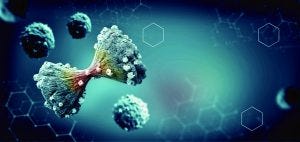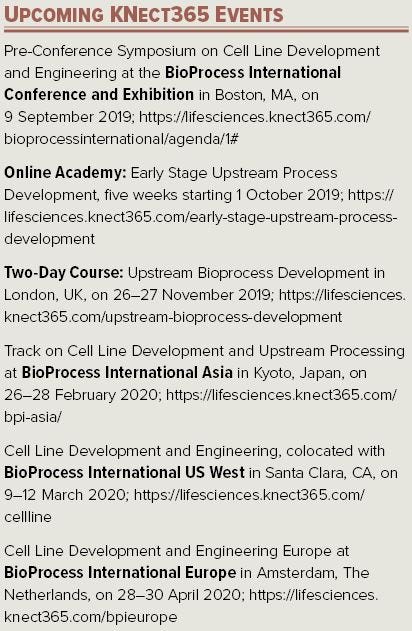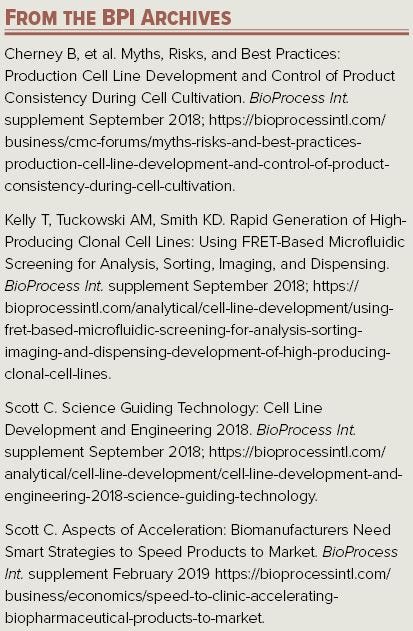Introduction: Reporting from the Frontiers of Cell Line Engineering at BPI Europe and BPI WestIntroduction: Reporting from the Frontiers of Cell Line Engineering at BPI Europe and BPI West
September 26, 2019

Image Credit: https://stock.adobe.com
Every biomanufacturing process begins with transfection of recombinant genes into pools of cells — followed by a succession of screenings from which will emerge (ideally) a single progenitor cell of the new production cell line. Cast aside will be those cells that do not uptake the correct genetic material, those incapable of thriving in bioprocess conditions, those that fail to produce recombinant protein at relevant levels, and those without demonstrated clonality and relative genetic stability.
Over the past several years, advancing technologies for genetic engineering, screening, clone selection, analysis, and data management have brought about a revolution in cell line development. Audiences at the BioProcess International (BPI) conferences have watched this field evolve as presenters shared their insights and reported on their experiences. This year’s BPI Europe and BPI West events continued in that vein with presentations on technology platforms, clonality, cell line (genetic) engineering, and development of biosimilars and other challenging product modalities.
 The Track at BPI Europe
The Track at BPI Europe
The BPI Europe conference and exhibition in Vienna, Austria, this past April devoted an entire track to cell line engineering and development. Speakers came from across the biopharmaceutical “ecosystem”: bioprocess suppliers, drug developers, and academia. They discussed genetics, new technologies, and case studies from the frontiers of the industry.
Genomics and More: Nicole Borth (professor at BOKU University and ACIB) focused on epigenetics of Chinese hamster ovary (CHO) cells in her talk, “Genome Scale Science for CHO.” She explained that scientists had spent 20 years hunting for a single gene to boost process performance of mammalian cell lines (whether overexpressed or knocked out/down) by improving productivity, growth, and product quality all in one fell swoop. Unfortunately, she said, such a “miracle gene” is not likely to exist.
An efficient cell factory, Borth said, results from “a complex interplay of many genes and activities. Productive cells reduce ‘unnecessary’ functions. They are efficient in providing precursors and energy.” Although certain pathways do come up time and again, the precise genes getting regulated differentially within those pathways will vary.
“Epigenetic regulation determines the transcriptome of each cell and cell type,” Borth explained. That includes different layers of regulation both for long-term “memory” and rapid response to changing culture conditions. And this makes epigenetics the second major contributor (after the genome itself) to phenotypic variation. She said that the true secret to control of gene expression will be to use epigenetics to determine phenotype and behavior. “The future of phenotype control will require more detailed understanding of gene expression regulation. Manipulating expression of multiple genes simultaneously requires synthetic biology and epigenetic control tools.”
In “Engineering Complex Traits in the Postgenomic Era of CHO Cell Line Development,” Nathan Lewis (assistant professor in the departments of pediatrics and bioengineering at the University of California, San Diego) echoed Borth’s conclusions. “Many desirable traits require multiple gene edits,” he explained. “Pathway knowledge and large data sets can guide cell engineering.”
As an example, he highlighted the risk of virus contamination of mammalian cell lines and cultures. Profiling virus-resistant cells points to regulators of resistance. In a case study, knocking out combinations of resistance repressors created virus-resistant cells.
Niall Barron (director of the National Institute for Cellular Biotechnology at University College Dublin in Ireland) turned the audience’s attention from DNA to RNA epigenetics in “Effect of RNA Epigenetics and Structure on Recombinant Protein Production in CHO Cells.” He highlighted the importance of a 5′ untranslated region (UTR) from mouse genetics in enhancing transgene translation. Its structure affects the stability of messenger RNA molecules.
“Manipulation of mRNA epigenetics represents a potential opportunity to manipulate the CHO production platform,” said Barron, “but better understanding will be required first.”
In “Designing Gene Expression Cassettes for CHO Cell Engineering,” Adam Brown (lecturer in DNA engineering for the department of chemical and biological engineering at the University of Sheffield, UK) emphasized the need for control of complex stoichiometric gene expression. He identified four categories of expression cassette design criteria: cell productivity, quality of expressed protein products, design simplicity, and control and stability of protein expression.
Focusing on design space, Brown described a quality by design (QbD) approach to expression cassettes. Designers must answer three questions: What can’t we control precisely (gene specificity)? What rates will we keep constant (set points)? and How will we achieve precise stoichiometries (control point)? Brown illustrated the testing phases that follow those decisions, identifying the ultimate goal as a system that enables robust, user-defined manipulation of gene expression stoichiometry.
“Further engineering is required to achieve highly predictable, fine-tuned control,” he explained, “and to achieve the objective design criteria.”
Advancing Technologies: Anton Bauer (senior scientist at the Medical University of Vienna) highlighted BESTcell technology from The Antibody Lab in “The BEST of Both Worlds — Targeted Integration and Multiple Copies: How Can This Go Together for Improved Cell Line Development?” He identified the challenge of developing highly productive stable mammalian cell clones within just three weeks from transfection.
Common methods for generation of stable mammalian cell lines include random integration of classical plasmid constructs; including chromatin modulators on those plasmids (for random integration of the plasmid constructs flanked by “antirepressors” for chromatin modulation); and knock-in approaches (using highly active host-cell loci for transcription of a transgene). But Bauer pointed out that silencing of the gene of interest (GoI) is a perennial problem to solve.
He pointed out how lessons from transgenic mice have helped scientists learn more about recombinant protein expression. Bacterial artificial chromosomes (BACs) can serve as expression vectors for recombinant protein production in mammalian cells. This is where the BESTcell approach comes in: It targets GoI integration into a “hot-spot” locus in vitro to generate multiple locus copies in CHO cells.
“BESTcell technology outperforms standard plasmid-based expression in stable clones,” said Bauer. “Transgene expression correlates with the number of integrations.” He showed a standardized process for cell line development without the need for antibiotic selection or amplification. “Multiple target-gene copies are integrated stably into a single integration site.”
Genetic stability and high yield (e.g., of human IgG1) with BESTcell clones have been demonstrated and maintained in long-term cultures. The system also has been proven with multiple types of proteins. Its capability has been tested in >50 case studies: standard and alternative IgGs, secreted polypeptides, “difficult-to-express” proteins, and IgAs. Bauer pointed out that BESTcell technology is used by Polymun for its EAVI2020 consortium work (http://www.eavi2020.eu) in good manufacturing practice (GMP) production of HIVgp140 (currently in a phase 1 clinical trial).
Whereas Bauer had focused on genetic “software,” Kerensa Klottrup-Rees (scientist of cell culture and fermentation sciences at AstraZeneca) touted new hardware in “Cytena Single Cell Printer (SCP): Advancing from Implementation to Robust Process.” In an evaluation study at her company, the instrument enabled progression to a single round of cloning with a six-week reduction in time lines. She said that it also was easy to use.
Side-by-side analysis of two projects comparing ClonePix and SCP processes showed at least equivalent titers, cell growth, and product quality despite the challenges of longer pool passaging, a lack of subcloning, and fewer data points available for review.
“SCP cloning has been implemented on five additional projects within the past year,” said Klottrup-Rees, “including novel molecules.” Quality and titer of the final clones in ambr microbioreactors (Sartorius Stedim Biotech) have been as good as or better than expected.
Subcloning of the host cell line and creation of new host pools has improved clone recovery. Evaluation of pooled hosts and clones is ongoing, but she said that data so far (up to shake-flask scale) show equivalent performance.
“Changing a single instrument has a massive implication for the whole process workflow,” she cautioned. But her company has been pleased enough with its evaluation of this new instrument that it will be worth the trouble. “Our future focus is on better use of the data to monitor trends and identify areas for improvement.”
Hannah Byrne (product manager at Valitacell) turned our attention to measurement of cell line properties in “Novel Analytical Solutions for Cell Line Development.” Her company offers semiautomated, microplate-based assay platforms (ChemStress and fluorescence polarization, FP) for a number of protein characteristics including titer.
“Our suite of simple, quantitative assays can assist in transforming the complex manufacturing process,” Byrne said. “Our patented technology allows us to create an assay applicable for any target using the FP platform. Migration toward in-line analytics is the future.”
Anke Mayer-Bartschmid (senior scientist of cell and protein sciences at Bayer) focused on data-driven decision-making using databases and analysis in “Making the Most Out of the Data Collected Along the CLD Process.” Such decisions enable selection of the best clones as well as continuous improvement through identification of highly productive clones, finding the right vector for a given system, and so on.
“Relevant and high-quality data must be stored in a searchable database,” said Mayer-Bartschmid. “Our database forces the input of structured data.” She explained that information should be made readily available for decision makers. “A database should enable fast analysis. The data have to be representative of the questions being asked.”
Analytical information must be engineered and stored, she explained, and then connected correctly. Accessibility through a central storage system and interfaces is important to allow for data collected over years to show correlations (e.g., certain glycosylation patterns dependent on cells, media, or the combination of both).
Case Studies: Sophie Broussau (cell line development specialist at Canada’s National Research Council in Montreal) reported on use of a new instrument in her case study, “Novel HEK 293 Cell Line Development for Upstream Production of a Viral Vector Using the CellCelector Nanowell Cloning System.” Lentiviruses are complex, enveloped retroviruses, she explained, best exemplified by the human immunodeficiency virus (HIV).
Broussau’s team used a CellCelector nanowell-based cloning system from Automated Lab Solutions (ALS) for cell line development of stable human embryonic kidney (HEK 293) cells to produce lentiviruses. The automated single-cell and colony-picking system takes and saves photos of every colony picked. It uses an ALS Flowbox incubator to maintain stable environmental conditions for living cells in culture.
Broussau concluded with a list of advantages her team found in using the CellCelector system: high levels of cell survival during cloning; complete documentation proving monoclonality; rapid clone analysis; straightforward workflows; and reduction of both time and materials needed to get results.
Martin Bertschinger (deputy director of cell sciences at Glenmark Pharmaceuticals) offered another case study in “Highlights from the Process Development of GBR 310, Glenmark’s Biosimilar for Xolair.” He emphasized the QbD approach: “process development with predefined objectives — beginning with the end in mind.”
Biosimilar developers must begin with a quality target product profile (QTPP) based on knowledge of the reference product. They generate a list of potential and identified critical quality attributes (CQAs). This requires development of an analytical strategy and analysis of innovator batches to provide target CQA ranges.
Bertschinger’s company used those development targets to guide in cell line development. Drug product CQAs were used to derive ranges for cell-population screening and selection. “We classified the CQAs roughly into three categories,” he said, “CQAs impacted by cell population, by process, and by both.”
The resulting production process was scaled to a 2,000-L bioreactor. Both physicochemical and functional biosimilarity were demonstrated using a tiered approach and appropriate statistical tools. Remaining differences were understood and considered to be clinically insignificant. And a phase 1 bioequivalence study has been successfully completed.
 Talks at BPI West
Talks at BPI West
Unlike BPI Europe, the conference in Santa Clara this past March did not include a dedicated track on cell line development and engineering. BPI West is organized differently: by product/process development stage (1). However, some speakers in the “Early Stage Process Development” track inevitably focused on cell line engineering topics.
Speed to IND: Yves Durocher (mammalian cell expression section head in the Human Health Therapeutics Research Center at the National Research Council of Canada) highlighted the need for speed in getting a product to the investigational new drug (IND) phase. “Are stable pools or transient gene expression viable manufacturing options?” was the main question of his presentation.
Focusing on CHO cells as the dominant mammalian expression system to manufacture biologics, Durocher highlighted the FDA’s assurance-of-clonality requirement. Without that, he explained, “additional control strategies would be needed on cell lines, product characterization, and processes to ensure product quality and homogeneity.”
However, accessing state-of-the-art technology platforms for generating CHO clones represents a “stark financial barrier” for small biotechnology companies. Beyond the initial licensing of a cell line, a master cell bank must be generated under GMP compliance. Otherwise, developing a CHO platform in-house requires time, specialized equipment and materials, and expertise.
Durocher described the investment in time and money required to make a clone for generating GLP toxicological materials as a significant obstacle to bringing new biotherapeutics into clinical testing, especially for smaller companies. They want to know whether other, faster manufacturing methods might be available.
Durocher pointed to three viable alternatives: transient gene expression (TGE), stable pools, and targeted (site-specific) gene integration — which he referred to as recombination-mediated cassette exchange (RMCE). In recent years, all three options have shown significant improvement in productivity (some achieving similar expression titers to those of stable clones), robustness, and product quality (again equivalent to that of material produced by stable CHO clones).
“TGE, stable pools, and RMCE do accelerate production of biologics,” Durocher said. Because their quality attributes can match those of stable clones, they can be used to generate material for toxicology (and even early clinical) studies. “The emphasis should be on product quality, safety, and process robustness,” he concluded, even when speed is the goal. These technologies for faster and more cost-effective manufacturing should facilitate the early stage development of biologics at small companies.
Getting Biosimilars Started: Michael Brem (senior scientist in cell line development at Cytovance Biologics, a Hepalink company) offered a case study to demonstrate successful development of a cell line expressing a biosimilar antibody. In particular, he reported on the use of a Gibco Freedom CHO-S kit from Thermo Fisher Scientific. In this collaboration between the two companies, Cytovance used mostly Thermo Fisher products to take a MAb-based biosimilar product “from DNA to toxicology.”
The goal was to use the Freedom kit to produce a stable cell line that would meet or exceed productivity targets (1–2 g/L). Brem’s team wanted to shorten the time line as follows:
DNA construction (weeks 0–5)
stable pool selection (weeks 5–10)
single-cell cloning and scale-up (weeks 10–14)
clone evaluation (weeks 14–16)
working cell bank for top eight clones (weeks 16–17)
process development and stability studies on top four clones (weeks 17–27)
toxicology-scale production campaign (weeks 23–27).
“Clone 9” was identified as the most solid and high-producing stable clone. It exceeded the productivity target (to >3 g/L) after process development in an ambr15 microbioreactor system (Sartorius Stedim Biotech). A timeline that used to take about a year was reduced to 27 weeks for this biosimilar monoclonal antibody. Brem said that using current Thermo Fisher catalog products was sufficient for development of this cell line. And he said that Clone 9 is a viable candidate to be used in future evaluations of Thermo Fisher products (new base and feed media).
Moving on to Perfusion: Finally, David Busch (senior scientist in preclinical development at Merck Research Laboratories, Kenilworth, NJ) looked toward the next step in “Bridging Clone Screening Platforms with Perfusion Bioreactors for Continuous Manufacturing.” Continuous manufacturing is of increasing interest in the biopharmaceutical industry.
Busch said that “mock perfusion” using deep-well plates allows for high-throughput clone selection in an emulated perfusion process. His team screened MAb-expressing clones in 24 deep-well plates and compared the results with those of TPP TubeSpin minibioreactors. “MAb-expressing clones have similar growth characteristics, productivities, and quality attributes using deep-well plates and TPP spin tubes in the mock-perfusion screening platform,” he explained.
Data showed that viable cell density and viability were comparable across media exchange volumes over five days. Exchange volume had no effect on accumulated titer or cell-specific productivity. The Merck team compared MAb-expressing clones from mock-perfusion cultures with those at a similar growth phase in 2-L perfusion bioreactor cultures and again found similar titers and cell-specific productivities, as well as quality attributes.
“The mock-perfusion deep-well–plate (DWP) format provides a high-throughput method for clone screening,” Busch concluded.
In This Report
The remaining articles in this BPI featured report expand discussion of genomics and cellular adaptation — the “nature” and “nurture” approaches to cell line development. First, Harvard professor Masahito Yamagata highlights the potential of advanced genetic engineering techniques for fine-tuning the capabilities of production and bioassay cell lines. Following that, authors from an Italian biopharmaceutical company show how they rapidly adapted a cell line to culture in defined media. Doing so allowed them to start with a relatively inexpensive cell line for their production process.
With speed and precision taking center stage, biotechnologists are looking to instrument suppliers and academic scientists in genetics and cell biology to help them push the envelope in cell line development ever further. See the “Upcoming Events” box for suggested live and online venues where you can take part in the future discussions.
References
1 Scott C. Knowledge Is Power: Intensifying Bioprocesses Requires Precision and Control. BioProcess International US West Event Report,15 April 2019; https://bioprocessintl.com/multimedia/ebooks/2019-bpi-west-event-report.
Cheryl Scott is cofounder and senior technical editor of BioProcess International, PO Box 70, Dexter, OR 97431; 1-646-957-8879; [email protected].
You May Also Like





